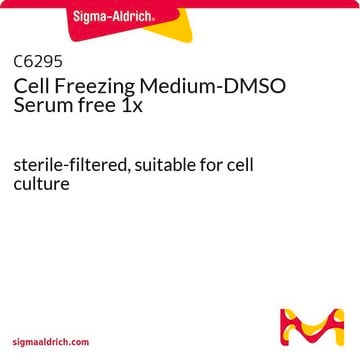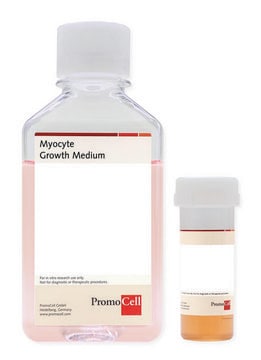51800C
Claycomb Medium
without L-glutamine, liquid, sterile-filtered, suitable for cell culture
Synonym(s):
HL-1 Medium
Sign Into View Organizational & Contract Pricing
All Photos(1)
About This Item
UNSPSC Code:
12352207
NACRES:
NA.75
Recommended Products
description
For research or for further manufacturing use.
sterility
sterile-filtered
form
liquid
storage condition
protect from light
technique(s)
cell culture | mammalian: suitable
components
L-glutamine: no
shipped in
ambient
storage temp.
2-8°C
Application
Claycomb Medium, named after Dr. William Claycomb who established the HL-1 cell line, is specifically designed for the growth of murine cardiomyocytes. HL-1 is the first cell line established that can maintain the differentiated cardiomyocyte phenotype and contractile activity in vitro. The HL-1 cell line can be used for the study of cardiac cell hypertrophy that follows myocardial infarction, the testing of novel cardiac therapeutic drugs and treatments, the production of high levels of cardiac proteins and the study of mature cardiomyocyte specific genes. Claycomb Medium, when supplemented with 100 μM norepinephrin, 10% fetal bovine serum (FBS) and 4 mM L-glutamine, will maintain the HL-1 cell line and the mature cardiomycyte behavior. While observing the HL-1 cells under light microscopy, individual and groups of cells can be observed contracting, becoming more frequent as the cardiomyocytes reach confluency.
also commonly purchased with this product
Product No.
Description
Pricing
related product
Product No.
Description
Pricing
Storage Class Code
12 - Non Combustible Liquids
WGK
WGK 1
Flash Point(F)
Not applicable
Flash Point(C)
Not applicable
Certificates of Analysis (COA)
Search for Certificates of Analysis (COA) by entering the products Lot/Batch Number. Lot and Batch Numbers can be found on a product’s label following the words ‘Lot’ or ‘Batch’.
Already Own This Product?
Find documentation for the products that you have recently purchased in the Document Library.
Customers Also Viewed
Jan Hendrik van Weerd et al.
eLife, 9 (2020-07-17)
Genome-wide association studies have implicated common genomic variants in the gene desert upstream of TBX3 in cardiac conduction velocity. Whether these noncoding variants affect expression of TBX3 or neighboring genes and how they affect cardiac conduction is not understood. Here
L A Sikkink et al.
Cell death & disease, 1, e98-e98 (2010-01-01)
Light-chain amyloidosis (AL) is a devastating protein-misfolding disease characterized by abnormal proliferation of plasma cells in the bone marrow that secrete monoclonal immunoglobulin light chains that misfold and form amyloid fibrils, thus causing organ failure and death. Numerous reports on
Yaopeng Hu et al.
Pflugers Archiv : European journal of physiology, 473(3), 507-519 (2021-01-05)
TRPM4 is a Ca2+-activated nonselective cation channel involved in cardiovascular physiology and pathophysiology. Based on cellular experiments and numerical simulations, the present study aimed to explore the potential arrhythmogenicity of CaMKII-mediated TRPM4 channel overactivation linked to Ca2+ dysregulation in the
Malou van den Boogaard et al.
Cell reports, 28(10), 2704-2714 (2019-09-05)
The human ether-a-go-go-related gene KCNH2 encodes the voltage-gated potassium channel underlying IKr, a current critical for the repolarization phase of the cardiac action potential. Mutations in KCNH2 that cause a reduction of the repolarizing current can result in cardiac arrhythmias
Yunchang Liu et al.
Cell death & disease, 11(9), 756-756 (2020-09-17)
In this study, we first established the doxorubicin-induced cardiotoxicity (DIC) model with C57BL/6 mice and confirmed cardiac dysfunction with transthoracic echocardiography examination. RNA-sequencing was then performed to explore the potential mechanisms and transcriptional changes in the process. The metabolic pathway
Our team of scientists has experience in all areas of research including Life Science, Material Science, Chemical Synthesis, Chromatography, Analytical and many others.
Contact Technical Service












